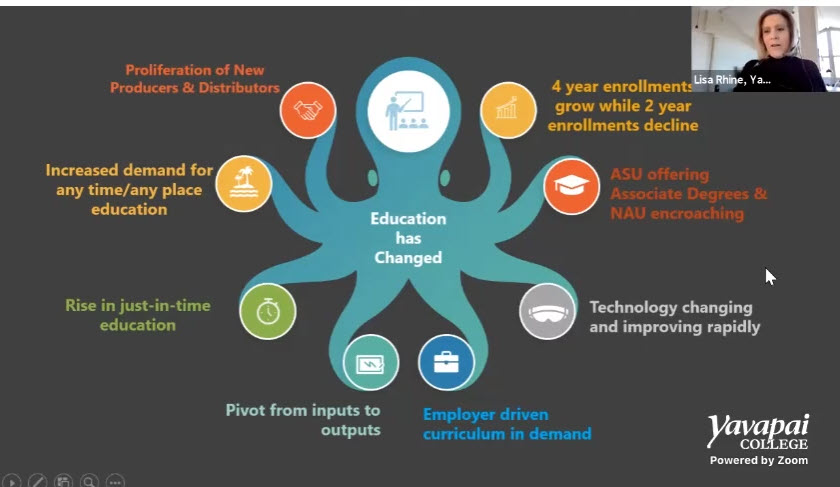ASU, NAU, Private industry and others all setting up programs to attract what were once traditional community college students taking more traditional community college courses; enrollment declining

CHART CREATED BY COMMUNITY COLLEGE AND SHOWN TO GOVERNING BOARD TO ILLUSTRATE CHALLENGES.
Yavapai Community College President Dr. Lisa Rhine outlined to the College District Governing Board during its February Workshop the increasing competition for tradition community college students that is coming from a wide variety of sources. She noted that over the last decade, enrollment in four-year public and private colleges and universities has brown by 12 and five percent respectively. Meanwhile, community college enrollment nationally had declined by 41% FTSE during this same period.
Arizona four-year college enrollment grew by 53% since 2011 (67,000 FTSE) while Arizona community college enrollment fell by 37% FTSE since 2011.
Arizona State University is moving into community college territory with its experimental Associate Degree in professional studies being offered to students at three high school groups. Northern Arizona University is likewise expanding its regional efforts to attract traditional community college students to its campuses.
There were many additional challenges coming from employers who, for example, want courses on specific topics immediately available to employees. Employers are also looking to private education providers who design educational programs specifically to meet their individual needs.
Technology is another challenge as it is changing rapidly and improving rapidly so the community colleges must harness these changes.
The Blog has listed below some of the areas of concern touched upon by Dr. Rhine during her presentation. You may view her short presentation on this topic to the Governing Board by clicking here.
AN OUTLINE OF CHALLENGES TO COMMUNITY COLLEGES
- Four year enrollments grow while two year enrollments decline
- ASU offering Associate Degrees & NAU encroaching on what has traditionally been the domain of community colleges.
- Public four-year colleges and universities grew by 12% since 2011 while private four-year colleges grew by 5% since 2011.
- Nationally, community colleges Full Time Student Equivalency (FTSE) declined 41% from its peak in 2011.
- Nationally, higher education shrank 12% since 2011. (Source IPEDS)
- Arizona Community Colleges FTSE declined 37% from its peak in 2011. (-50,000 FTSE)
- Arizona four-year college enrollment grew by 53% since 2011. (+67,000 FTSE)
- About 30,000 FTSE of Arizona four-year college increase comes from lower division Arizona residents.
- ASU looks to start two year Associate in Arts degree trial program, moving in on community college territory. The Associate Degree in professional studies will be offered to students at three high school groups.
- NAU, statewide partners launch Arizona Attainment Alliance, to improve educational attainment and drive economic mobility in Arizona. Asking for universal admission with the community colleges meaning that any student admitted to a community college would also be admitted into NAU.
- NAU Regional Centers: NAU Online and Innovative Educational Initiatives is seeking four (4) experienced and motivated Regional Director’s to join its team. The Regional Director is responsible for the development and cultivation of student and faculty centric strategic partnerships for the university.
- NAU says that there are four (4) positions available to be located within the following regions. Northern Region: Apache, Navajo, Gila, Coconino, Mohave; Central Region: Maricopa, Pinal, Yavapai; Southeastern Region: Pima, Santa Cruz, Cochise, Graham, Greenlee; Southwestern Region: Yuma, La Paz.
- There has been a proliferation of new producers and distributors of educational offerings.
- Increased demand for any time any/place educational offerings.
- There has been an increase in demand for “just in time” education. Used to teach students classes and courses in what is characterized as “just in case.” It used to be you took a course just in case you needed it in the future. Now is seems to be that students want educational courses just to prepare you for “that specific job.”
- Pivot from inputs to outputs. They want to see competencies in certain level skills that are valued by employers.
- Employer driven curriculum is in demand. In the past the College would tell a student that “this is what you need to know.” Now employers are telling the College that their employees need to know “X, Y and Z.”
- Technology is changing rapidly and improving rapidly so the community colleges must harness these changes.
